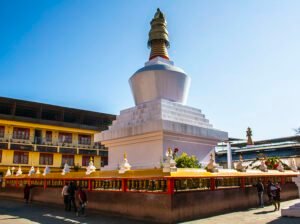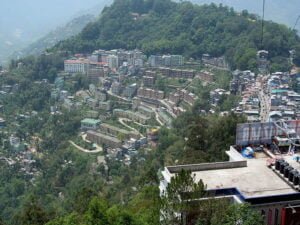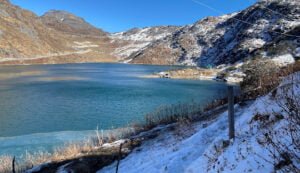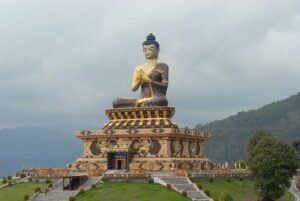No products in the cart.
A unique destination in the Northeast
Sikkim
Top 10 Tourist Attractions of Sikkim – With its intriguing culture and delicious culinary offerings
Gangtok
Gateway to the great treasures of Sikkim, the state capital is a bustling commercial and cultural hub located in the east district at 2,500m. Visitors in the city around at the time of the vibrant Sawa Dawa festivities, watching the procession of the monks carrying the sacred books of Buddha’s teachings from the Tsuklakhang Monastery in the palace to different parts of town are reminded of the strong Buddhist presence in the city. It also a small taste of the tempting cultural experiences in store for them as they journey around the state. On a clear day, the superb views of Mt Khangchendzonga draw one’s attention to Sikkim’s amazing natural heritage.

Step into the quiet environs of the Namgyal Institute of Tibetology and you’ll discover how this world-renowned centre for Buddhist philosophy and religion, which houses the world’s largest treasury of invaluable old Tibetan books and manuscripts on science, medicine, astrology etc, is such huge magnet for Buddhist scholars from all over the world. The institute also opens up a window, through the beautiful collection of vintage scrolls and manuscripts Sikkim’s connection to the Lepcha community, the indigenous peoples of the state and neighbouring Nepal. You should pop into the mall orchidarium which houses over 200 species of orchids.
Tsuklakhang

Is the nucleus for many of the grand rituals and ceremonies held at the royal chapel in the palace. The monastery houses a fantastic collection of monastic art, wall paintings, superb wood carvings and liberally decorated altars with images of the Buddha, Bodhisattvas and the Tantric deities. As you stroll around the place you will see robed lamas going about their daily business.
In the lively bazaars, you can shop for hand-woven carpets with traditional Tibetan designs, thangkas, Lepcha-weave bags, purses, leatherware, woodwork, Sikkimese spirits and liqueurs. As a souvenir for friends pick up the famous silver ‘Dragon Rings’ from jewellery/souvenir shops. A ‘Chokee’, a collapsible wooden table with Tibetan carved designs is a good buy. Check out the Cottage Industries Institute, where you can watch artisans at work weaving, creating wood-carved marvels and painting thangkas.
Rumtek
On your way to Rumtek monastery, 35km away from Gangtok, stop for impressive views of the Khangchendzonga range from the Enchey Monastery (5 km) and Tashi Viewpoint (9 km).
Its origins date back to the 18th century with Changchub Dorje, the 12th Karmapa Lama directing its construction. It served as the bastion of the Karma Kagyu lineage in Sikkim. By the time His Holiness Gyalwa Karmapa, the ninth incarnate of the original Gyalwa Karmapa of Tibet and head of the Karguypa sect arrived in Sikkim after fleeing from Tibet in 1959 Rumtek was in ruins. The Chogyal of Sikkim gifted him some land to establish a new monastery but His Holiness opted to rebuild Rumtek. A world-renowned centre for Kargyu teachings, and the largest Buddhist monastery in Sikkim it is now the residence of His Holiness the Gyalwa Karmapa of the Kargyu sect and the headquarters of the Dharma Chakra Religious Centre. Visitors are impressed by its beautiful traditional architecture and the Tibetan monastic art. Another highlight is the Golden Stupa; the chorten is gilded in silver and gold and encrusted with gemstones. About 2km away is the old Rumtek Monastery built in the reign of the fourth Chogyal. It has been completely renovated.
Tsongo Lake and Nathu La

The ethereal environs of the mystical Tsongo Lake and historic Nathu La are evergreen excursions for travellers visiting Gangtok. For security reasons their vertiginous heights can only be visited through government-recognised agents who arrange the entire trip which combines both places; this includes permits and vehicles for the beautiful drive. In winter Tsongo/Changu Lake (3780 m) is an icy wonderland; in summer it witnesses the splash of a thousand blooms. A part of the ancient Silk Route the historic Nathu La Pass (14,200ft) was a vital trade link between India and Tibet. Closed for four decades after the Chinese repression of Tibet in 1959, it was reopened in 2006. Today it plays a significant role in the Sino-Indian trade.
Ravangla

Emerging as a new tourist hotspot serene and sleepy Ravangla/ Rabongla on the Gangtok-Gaysiling highway in south Sikkim is excellent for short treks in the area. Travellers are discovering its other charms, such as the blooming of thousands of flowers between April and May. Tathagata Tsal or Buddha Park, a relatively new structure attracts many visitors. The 130-ft high statue of Sakyamuni Buddha draws your attention to the line-up of snowclad peaks which serve as a splendid backdrop to the statue. It was consecrated by His Holiness the Dalai Lama to mark the 2550th birth anniversary of Buddha. A popular stopover is the hot spring known as Ralong Cha Chu. One can also visit Ralang Monastery, the Bon Monastery and the Doling Monastery, accessible via a nice trek. Check out the Kheunpheling Carpet Centre.
Yumthang Valley

The splendours of the Eastern Himalayas can be enjoyed from many perspectives in Sikkim which is home to 28 mountain peaks, 80+ glaciers, 227 high-altitude lakes, five major hot springs, and over 100 rivers and streams. The pretty Yumthang Valley in north Sikkim, 140km from Gangtok, offers unparalleled natural experiences of the region. Sikkim’s ‘Valley of Flowers’, surrounded by mighty snow peaks and watered by the Lachung River can be enjoyed through all seasons. For the blooming of the rhododendrons arrive here at the Shingba Rhododendron Sanctuary between March and April. The drive itself from Lachen is spectacular. You can also picnic by the serene Yumthang Chu.
Pelling
From its lofty heights at 2000m in West Sikkim, Pelling is a major hub for adventure-loving travellers. The pretty township with its breathtaking beauty falls between two other popular monastic destinations—Pemayangtse and Sangacholing. Its old forested enclaves have been the ancient stamping grounds of a plethora of indigenous wildlife species, both from the animal kingdom and the avifaunal world. About 10 km from Geyzing and 130 km from Gangtok, it offers compelling views of the Khangchendzonga range.
Bakkhim
A magnet for decades for trekkers and climbers heading off for Dzongri, 10 km away, Bakkhim itself is a delight for botanical buffs and nature lovers. It is home to over 20 varieties of rhododendrons alone. Refuel yourself with those superb up-close views of the Khangchendzonga range.
Yuksom
This popular trekking hub is steeped in spiritual importance for Buddhists in Sikkim. The name literally means the “meeting of three great lamas” as it commemorates the meeting of three holy men who arrived from Tibet to set up the Nyingmapa order of Tibetan Buddhism in Sikkim. The first ruler of Sikkim was also consecrated at this hallowed site. Yuksom is also the jump-off point for the beautiful Khangchendzonga National Park. The Himalayan Mountaineering Institute uses Yuksom as the base for its mountain climbing course.
Dzongri
The gorgeous vistas are best enjoyed by a leisurely trek through this scenic upland. Dzongri’s forested enclaves are home to exotic species like the red panda and avifaunal favourites such as the black khaleej pheasant and the yellow-necked woodpecker. If you’re here during the seasonal blooming of the many varieties of rhododendrons on the hillsides, this trek will always remain embedded in your memory. Unforgettable too are the magnificence views of the Khangchendzonga massif. You can enjoy interactions with the locals at Tsoka village, just before Dzongri; some of the villagers here have even travelled to Switzerland to learn all about high-altitude farming; as a result, they have developed ginger, potato and cabbage farms. The Khangchendzonga Base Camp is located at Chourikhiand just 7km away from Dzongri.
Pemayangtse
An important 17th-century base for Sikkim’s Nyingmapa order Pemayangtse Monastery stands at a height of 2085 m in the shadow of the mighty snow peaks of the Eastern Himalayas. Sikkim’s first Chogyal was crowned here in 1641. The second oldest monastery in the state it houses a beautiful collection of icons and objects of worship of deep antiquity. The walls and ceilings are liberally illustrated with frescoes of gods and demons in bright colours.
One can visit nearby Rabdentse which once served as Sikkim’s capital and is home to the ruins of a palace. One can also make the trip up to the Tashiding Monastery which dates to 1717. It’s the holiest place for Sikkim’s Buddhist populace. Guru Padmasambhava is said to have visited the shrine in the 8th century CE. A common belief amongst devotees is that even a glimpse of the Thong-Warang-Drol Chorten of the holy lama Lama Ngadag Sempa Chhenpo can cleanse you spiritually. It houses the precious relic of the Mythical Buddha “Wod-Srung” antecedent to Buddha Shakya Muni. In the spring the annual Bhumchu Festival attracts throngs of devotees. Pemayangtse is also a base for the Yuksom trek.
















